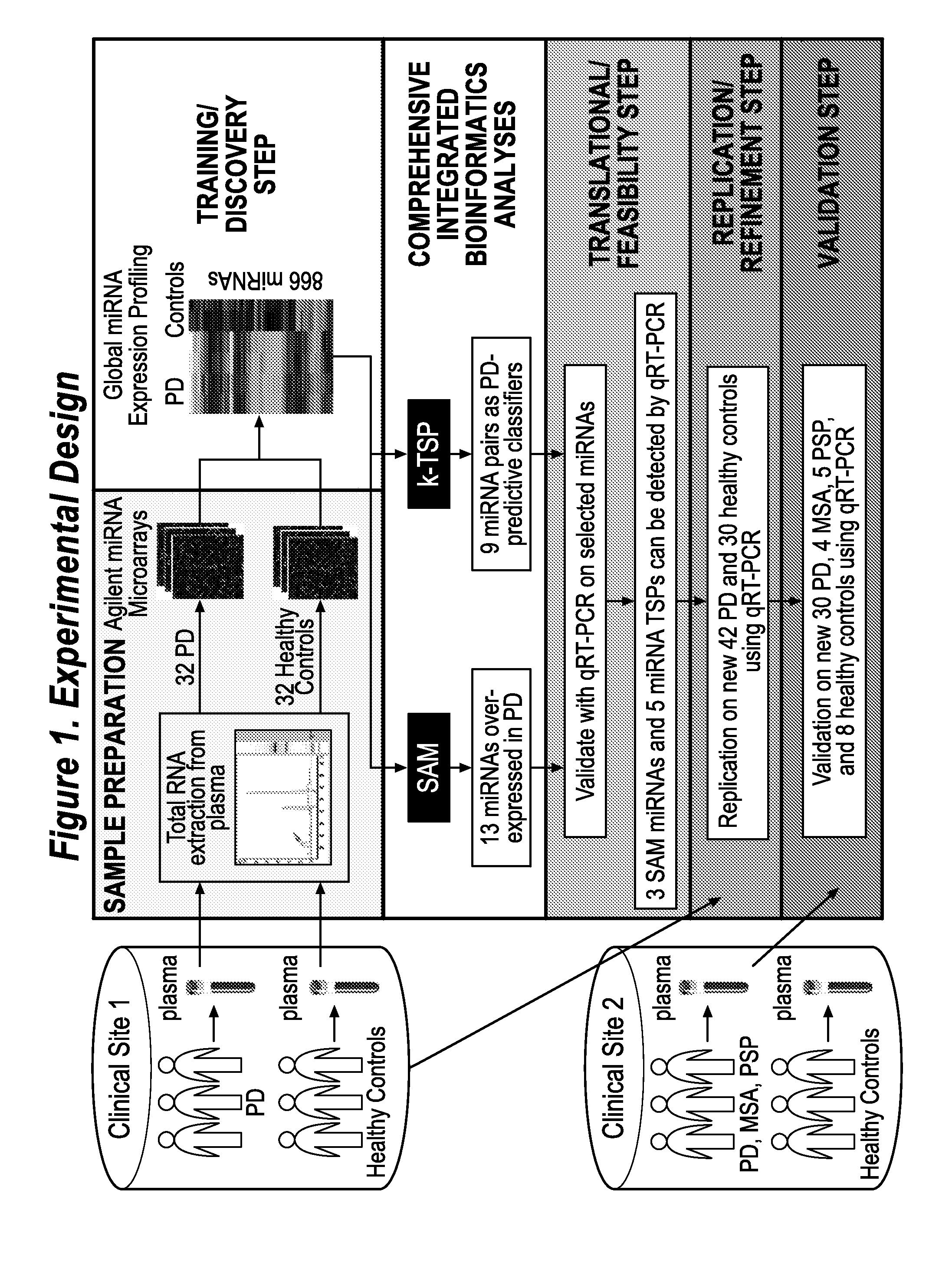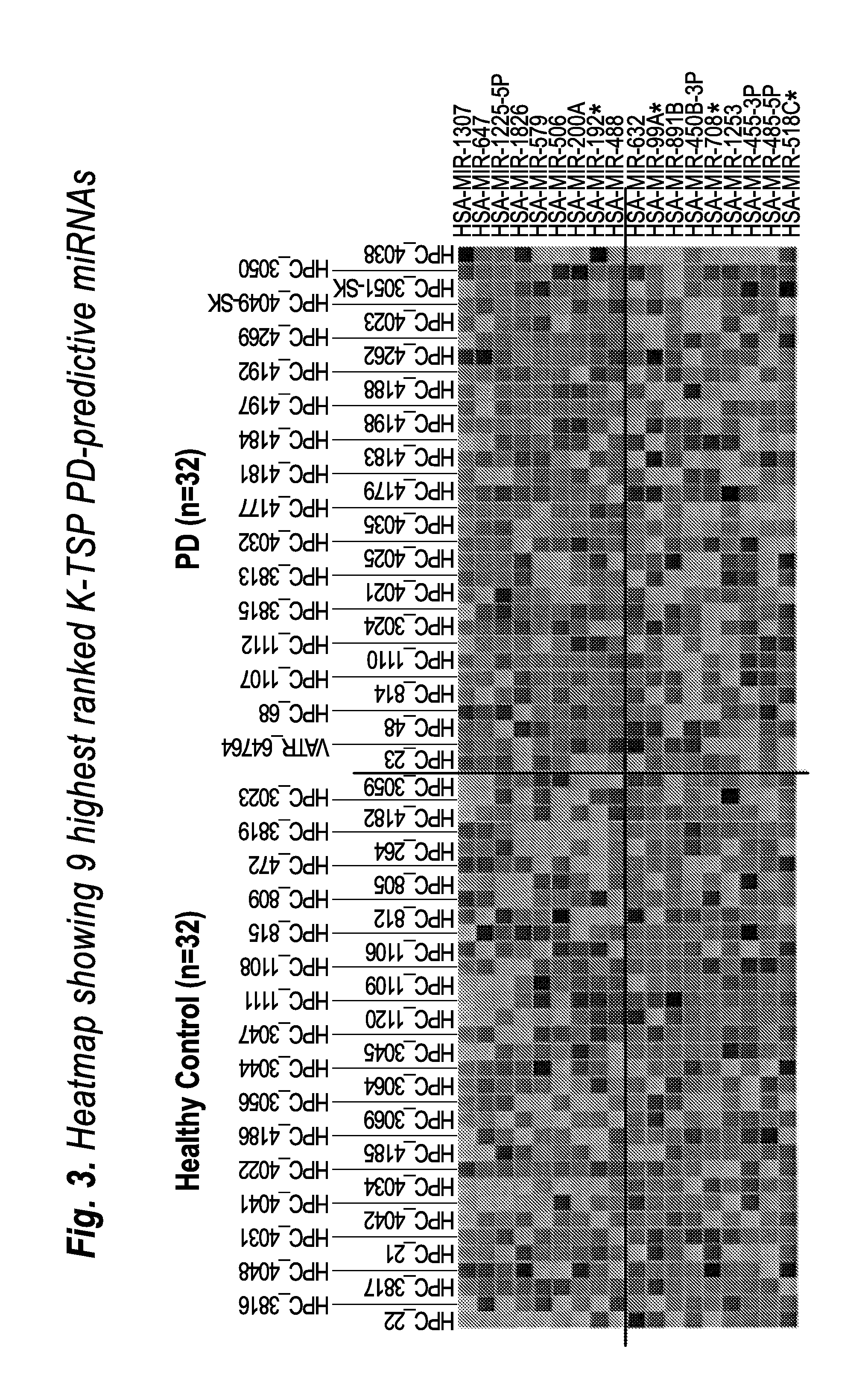MicroRNA Biomarkers for Diagnosing Parkinson's Disease
a biomarker and microrna technology, applied in the field of microrna biomarkers for diagnosing parkinson's disease, can solve the problems of 60-70% of the patient's dopaminergic neurons already lost, subjective clinical assessment, and inability to diagnose pd 100% even by experienced movement disorder specialists, etc., to achieve the effect of high predictive power and positive predicted valu
- Summary
- Abstract
- Description
- Claims
- Application Information
AI Technical Summary
Benefits of technology
Problems solved by technology
Method used
Image
Examples
example 1
Materials and Methods
[0137]The experimental design for this study is shown in FIG. 1. Plasma samples of healthy controls and PD patients were obtained from the St. Mary's Health Care Hauenstein Parkinson's Center in Grand Rapids, Mich. In addition, PD, PSP, MSA patients and healthy controls recruited from the Department of Neurology at Umeå University Hospital (UUH) were used as a new, independent validation set. All subjects provided their informed consent and this study was approved by the institutional review boards of Saint Mary's Health Care, Umeå University Hospital, and the Van Andel Research Institute. PD patients were evaluated according to the UK PD Diagnostic Criteria with Hoehn and Yahr staging. Peripheral blood samples were obtained using 10 ml EDTA tubes, placed on ice immediately and centrifuged at 4° C., 1,000 g for 15 minutes. Plasma supernatant was aliquotted into 500 μl aliquots and stored immediately at −80° C. until analysis. Patient characteristics are shown in...
example 2
Brain- and Plasma-Specific miRNAs can be Detected in Plasma Using miRNA Microarrays
[0143]In a preliminary study, 24 brain-specific miRNAs that were reported by Kim et al. [(2007) A MicroRNA feedback circuit in midbrain dopamine neurons. Science 317:1220-1224] and 54 plasma-specific miRNAs cited by Mitchell et al. [(2008) Circulating microRNAs as stable blood-based markers for cancer detection. Proc. Natl. Acad. Sci. (USA) 105:10513-10518] were detected in our healthy control plasma (FIG. 2A). In addition, 35 miRNAs in the healthy control plasma that were also expressed in the commercially available human brain tissue reference were also detected (FIG. 2B). These results showed that it is feasible to detect brain- and plasma-specific circulating miRNAs in plasma.
example 3
K-TSP Defined 9 Pairs of PD Predictive miRNA Classifiers
[0144]Using the novel k-TSP algorithm [Tan, A C et al. (2005) Simple decision rules for classifying human cancers from gene expression profiles. Bioinformatics 21:3896-3904], the use of which has proven feasible to handle small sample learning problems and generate accurate classifiers [Rajeshkumar N V, et al. (2009) Antitumor effects and biomarkers of activity of AZD0530, a Src inhibitor, in pancreatic cancer. Clin Cancer Res 15:4138-4146; Pitts T M, et al (2010) Development of an integrated genomic classifier for a novel agent in colorectal cancer: approach to individualized therapy in early development. Clin Cancer Res 16: 3193-3204], 9 pairs of PD-predictive miRNA biomarkers were identified from the microarray data.
[0145]The 9 paired classifiers were miR-1307 / miR-632, miR-647 / miR-99a*, miR-1225-5p / miR-891b, miR-1826 / miR-450b-3p, miR-579 / miR-708*, miR-506 / miR-1253, miR-200a / miR-455-3p, miR-192* / miR-485-5p, and miR-488 / miR-51...
PUM
| Property | Measurement | Unit |
|---|---|---|
| stability | aaaaa | aaaaa |
| real-time | aaaaa | aaaaa |
| heat map | aaaaa | aaaaa |
Abstract
Description
Claims
Application Information
 Login to View More
Login to View More - R&D
- Intellectual Property
- Life Sciences
- Materials
- Tech Scout
- Unparalleled Data Quality
- Higher Quality Content
- 60% Fewer Hallucinations
Browse by: Latest US Patents, China's latest patents, Technical Efficacy Thesaurus, Application Domain, Technology Topic, Popular Technical Reports.
© 2025 PatSnap. All rights reserved.Legal|Privacy policy|Modern Slavery Act Transparency Statement|Sitemap|About US| Contact US: help@patsnap.com



